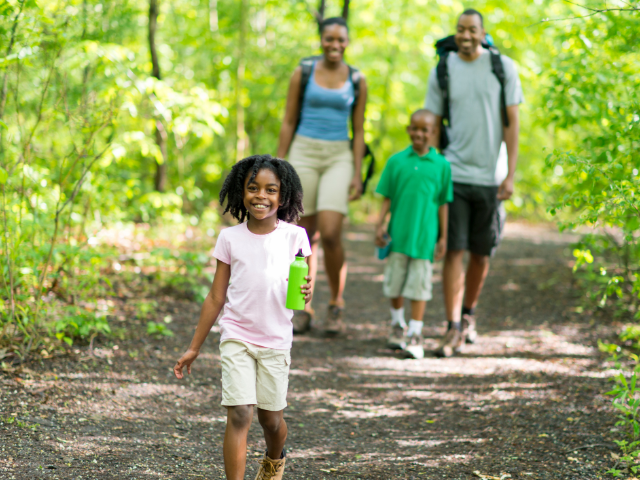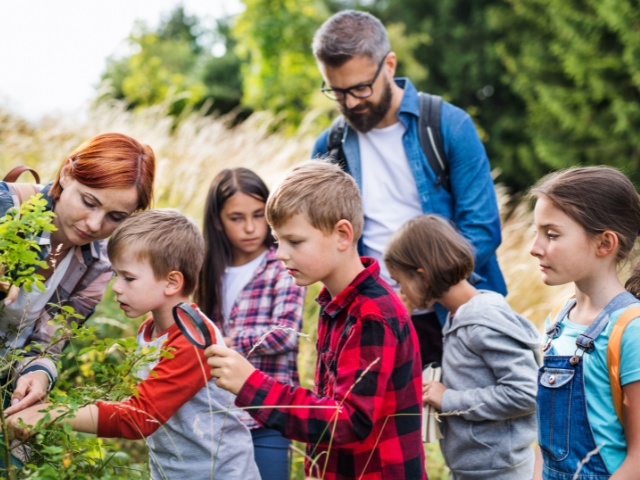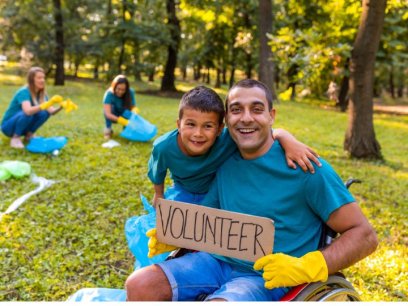
Picture this: you’re planning your next volunteer event in the outdoors and it’s all starting to come together. You’ve chosen a venue and a goal. All the logistics are set. Now, it’s time to get the word out.
When recruiting volunteers for a National Public Lands Day event or other community engagement activity, don’t forget to communicate about the health and wellness benefits of nature. Make sure that participants understand all that they can gain from getting involved. Giving back to your community by volunteering inherently feels good—but being active outside is beneficial for your physical and mental health as well.
NEEF developed our health and wellness engagement guide in partnership with the National Park Service and the USDA Forest Service that outlines key strategies for planning and executing successful environmental education and health and wellness events on public lands. Download the guide to find best practices, lessons learned, and tips for success when developing effective messaging around your own event.
Physical Wellness Messaging
The connection between physical activity and health is well-documented. Research continues to make new breakthroughs about how being active in the outdoors helps prevent chronic disease. Below are some specific examples of the link between exercise in nature and positive health outcomes for both adults and children.
- People exercise for longer periods of time and at greater intensities in natural environments.
- Children who spend time outdoors experience increased physical activity. For every hour a week a child spends outside, their physical activity increases by 27 minutes.
- Spending at least 120 minutes a week in nature is associated with good health and wellbeing.
- Children who are regularly exposed to nature have a lower risk of developing myopia, also known as shortsightedness.
- Physical exercise outdoors reduces blood pressure and improves mood.
- When individuals exercise outdoors, they experience a greater reduction in blood pressure and improvement in mood than when exercising in indoor settings.
- Natural environments contain chemical and biological agents that can boost immune functions and promote human health.

Mental Wellness Messaging
Green spaces are also important tools for mental wellness. Time spent in nature reduces stress and improves the mental health of people of all ages. These key messages highlight how getting outside can impact your mood and brain.
- Nature makes you more creative. Experiencing the wonder of nature can inspire people to solve problems more creatively and cooperatively.
- Nature has significant restorative properties; it can renew depleted cognitive functions and improve performance.
- Nature provides a place and an opportunity for play and physical activity. Play is critical for children, as it aids in the development of cognitive thinking and reasoning skills.
- Nature encourages exploration and building, which improves problem solving, decision making, and the ability to respond to changing contexts. For adults, incorporating exercise into time in nature can help increase the brain’s cognitive capacity.
- Exposure to nature, even passive experiences such as looking out over a view of nature, can reduce stress levels. For those with high levels of stress, physical activity in nature can be beneficial for both physical and mental health.
- People living near parks and greenspace have less mental distress, are more physically active, and have extended lifespans.
- Especially in children, nature acts as a buffer for stress and can reduce overall stress levels.
- Contact with nature can provide relief and healing for those who suffer from acute and chronic mental illness, including depression, anxiety, mood disorders, and dementia.
- Nature can serve as a safe, inexpensive, and widely accessible tool for managing ADHD symptoms.
- Time in nature can help people with depression. After a 90-minute nature walk, individuals reported fewer repetitive thoughts focused on negative features of the self and a decrease in neural activity in a part of the brain linked with sadness and self-reflection.
Get the Word Out with Local Healthcare Partners
One way to make the connection between the outdoors and health especially clear is to collaborate with a local healthcare provider. Build relationships with potential community partners long before your event. Introduce yourself to the health community by attending conferences and connecting with local hospitals, physician practices, and departments of health.
Doctor-led activities on public lands can inspire people to live a healthier lifestyle in nature with the support of a health professional. Physicians can lead a variety of hands-on activities, such as walks and tree planting.
During these events, physicians can talk about how the activity improves people’s health and facilitate discussion between participants about health topics. It’s truly a win-win for everyone involved: participants benefit from exercise, health education, and social interaction, and doctors benefit by building meaningful connections with members of their community.
The key to hosting a successful outdoor volunteering event is truly knowing your community and thinking creatively about how to reach people who are not typically getting exercise. Consider how you can make an event especially fun or worthwhile for them, be it through giveaway items like pedometers or coupons for free admission to the park.
Incorporate messaging about the health benefits of nature into your advertisements for the event early and often using flyers and social media. Building a committed group of volunteers can help you get the word out to key audiences and create lifelong stewards for public lands.

Learn More About Communicating the Health Benefits of the Outdoors
Use these resources to integrate health and wellness into your next National Public Lands Day event or other community volunteer engagement activity:
- NEEF Public Lands Engagement: Health & Wellness in Nature: Download the guide to learn how to incorporate high-quality health and wellness activities at local events and how to promote them within your community.
- NPS Healthy Parks Healthy People: This National Park Service campaign promotes the fact that parks are gateways to good health—for people and the planet. Engagement guides highlight programs that make well-being a priority in parks and communities all across the country.
- Walk with a Doc: Guide to Getting Started: Since 2005, Walk with a Doc has helped thousands of healthcare providers and community leaders start walking programs in communities around the world.
- NEEF NPLD Promotional Toolkit: This downloadable guide and webinar will help you spread the word about your outdoor volunteer event, draw in volunteers of all ages from your community, and engage with local media.
- NEEF Site Manager Guide: Your resource for planning and executing a successful National Public Lands Day Event, this guide supports new and returning site managers in planning and executing successful NPLD events.


